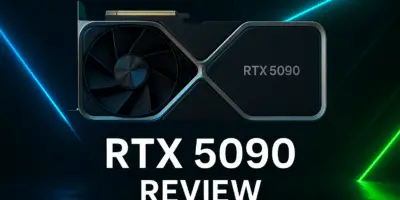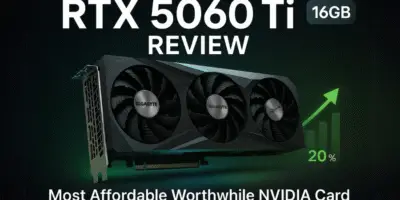Let’s face it—choosing the right graphics card is never straightforward, especially when you’re looking at the mid-range market where price-to-performance ratios really matter. Today, I’m diving into a head-to-head comparison that many of you have been asking about: the AMD Radeon RX 9070 priced at $550, versus NVIDIA’s RTX 5070 also at $550, and the slightly more affordable RTX 5060 Ti 16GB at $429.
Many of you have been messaging me with variations of the same question: “Is it worth paying that extra $120 to go from the 5060 Ti to either the 9070 or 5070?” It’s a great question, and one I’ve been eager to answer properly.
Table of Contents
The Specs Breakdown
Let’s start by quickly running through what each card brings to the table.
NVIDIA’s Lineup
Both NVIDIA cards are built on the Blackwell architecture:
- RTX 5060 Ti: Comes with 16GB of GDDR7 memory (also available in an 8GB version)
- RTX 5070: Equipped with 12GB of GDDR7 memory
Honestly, the memory configuration feels backwards to me—I would’ve expected the higher-tier 5070 to have 16GB and the 5060 Ti to have 12GB, but that’s NVIDIA’s decision.
In terms of raw power, the 5070 has about 25% more CUDA cores than the 5060 Ti, with similar improvements in shader units, tensor cores, and RT cores. The 5060 Ti does have slightly higher clock speeds, but don’t let that fool you—the 5070 delivers about 25% better performance in benchmarks and 22% better gaming performance at 1440p resolution.
Power consumption is where you’ll see another difference: the 5060 Ti draws 180W while the 5070 pulls 250W under load.
The AMD Contender
The RX 9070 is AMD’s answer to NVIDIA’s offerings, and honestly, its naming system is a bit different. Performance-wise, it actually competes with (and sometimes beats) the RTX 5070 Ti in synthetic benchmarks, though gaming performance varies depending on the title and what technologies are being used.
Looking at the specs:
- 56 compute units
- Over 3,500 stream processors
- 112 AI accelerators
- 56 ray tracing cores
- Core clock speeds of around 2520 MHz, though I’ve seen it boost up to 3100 MHz in some games
One thing I really appreciate about the 9070 is its memory configuration. AMD has equipped it with 16GB of GDDR6 memory on a 256-bit interface, allowing for 644 GB/s of bandwidth. While NVIDIA opted for faster GDDR7, AMD’s approach gives you more memory and sufficient bandwidth without driving up the cost.
Power consumption lands at 220W, positioning it between the 5060 Ti and 5070 in terms of energy requirements.
The Test Subjects
For my testing, I used:
- A Gigabyte RX 9070 Gaming OC model
- An MSI RTX 5060 Ti Gaming X model
- A Gigabyte RTX 5070 Gaming OC model
A quick note on thermals: the Gigabyte 9070 runs incredibly cool at just 48°C under load—seriously impressive and suggests excellent overclocking potential. The MSI 5060 Ti runs at around 66-67°C with its dual-fan design (which is good for NVIDIA cards), while the Gigabyte 5070 manages about 62°C.
Synthetic Benchmarks: A Promising Start
In 3DMark’s Speed Way test, the RX 9070 blew past the competition:
- 21% faster than the RTX 5070
- 41% faster than the RTX 5060 Ti
This pattern continued across other synthetic benchmarks:
- Port Royal: 12% faster than the 5070 and 35% faster than the 5060 Ti
- Time Spy Extreme: 20% faster than the 5070 and 42% faster than the 5060 Ti
- Fire Strike Extreme: Similar results with the 9070 outpacing the 5070 by over 20% and the 5060 Ti by over 30%
Content Creation: A Different Story
Here’s where things get interesting—and a bit disappointing for AMD fans. In content creation workloads, the 9070’s performance drops dramatically compared to the NVIDIA cards.
In Blender, the 9070 performs at less than half the speed of both NVIDIA cards. The same goes for V-Ray, which isn’t well optimized for AMD GPUs.
This raises an important question for users who both game and create content: Do you need separate machines for different tasks? Or do you compromise and go with NVIDIA for better all-around performance, even if it costs more?
Gaming Performance: A Mixed Bag
When it comes to gaming, the results vary significantly depending on the game and what technologies are being used.
With Ray Tracing and DLSS/FSR
In Black Myth: Wukong at 1440p with ray tracing enabled and DLSS/FSR set to Quality mode (no frame generation), the results were shocking:
- RX 9070: Just 22 fps
- RTX 5060 Ti: Noticeably better
- RTX 5070: About twice the performance of the 9070
These results were consistent at 1080p as well, with the 5070 still delivering double the performance of the 9070 and the 5060 Ti outperforming it by about 27%.
Without Advanced Technologies
But when we turn to games without ray tracing or upscaling technologies, the story changes completely.
In Far Cry 6, which traditionally favors AMD hardware, the 9070 dominates:
- 21% faster than the RTX 5070
- 30% faster than the RTX 5060 Ti
Similar results were seen in Assassin’s Creed Mirage with no advanced technologies enabled, and Shadow of the Tomb Raider also showed the 9070 maintaining a lead, albeit with a slightly smaller margin over the 5070.
But when we go back to technology-heavy titles like Watch Dogs: Legion, the 9070 again falls behind both NVIDIA cards.
The Verdict: Which Card Should You Buy?
AMD’s RX 9070 delivers impressive raw performance at its $550 price point. With 16GB of VRAM, excellent thermals (just 48°C under load), and improved encoder support for content creators, it has a lot going for it.
However, AMD still needs to work on compatibility with software and game developers. As you’ve seen, performance varies wildly depending on whether ray tracing and other advanced technologies are being used.
So, is it worth paying that extra $120 over the RTX 5060 Ti? Here’s my take:
- For content creation: Go with NVIDIA. Period. Whether it’s the 5060 Ti or 5070, they’re simply better for productivity applications.
- For gaming with ray tracing and AI upscaling: Again, NVIDIA has the edge. If you love cranking up all the visual settings and using DLSS, the 5070 is your best bet, with the 5060 Ti as a more budget-friendly option.
- For pure rasterization gaming: The RX 9070 is the clear winner here. If you don’t care about ray tracing or AI upscaling and just want raw gaming performance, AMD delivers the goods.
And here’s a final thought: AMD typically drops their prices by $50-70 after the initial launch period. If the 9070 comes down to around $470-500, it would become an incredible value proposition for gamers who don’t need the latest ray tracing tech.
Ultimately, your choice depends on your specific needs and the games you play. No single card wins across the board, which is actually great news for consumers—competition is alive and well in the GPU market!
What’s your take? Which of these cards would you choose for your setup? Let me know in the comments!


